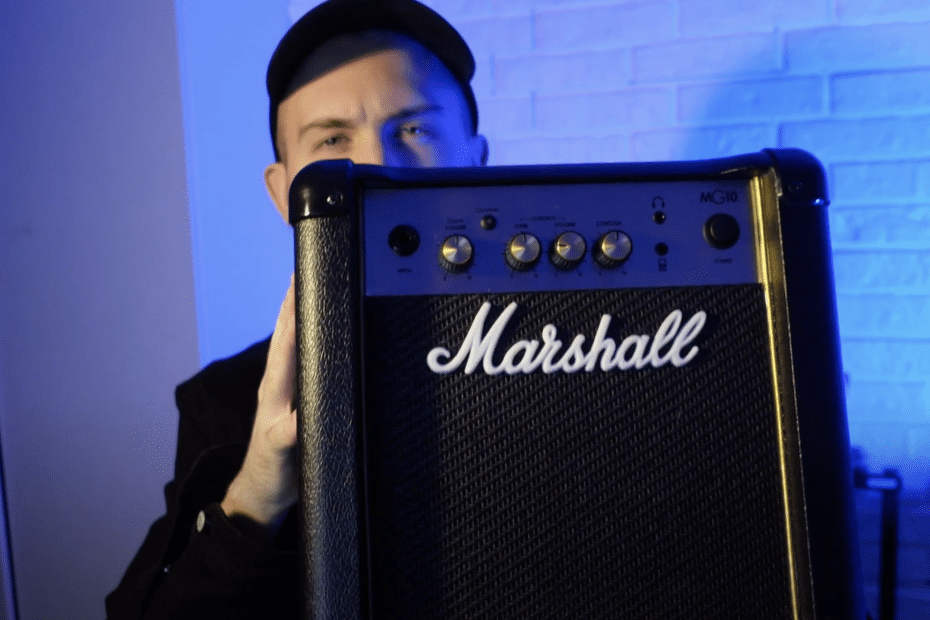Marshall MG10 is a super popular combo, especially among the beginner guitarists.
BUT is it actually the best option out there?
I tried it so you don’t have to. Let me show you what I learned.
Features

The MG10 offers 10 watts of power—just enough to fill a small room but not enough to annoy the neighbors. It has two channels: clean and overdrive. The clean channel is decent for those crisp, clear tones you’re after, while the overdrive channel gives you that gritty Marshall crunch.
Not exactly a beast, but it does the job.
The 6.5-inch speaker is small, but it’s a tough little guy. It’s not going to blow you away, but it’s enough to keep your jams interesting. The Contour tone control lets you shape your sound a bit. It’s a nice touch, though it won’t turn this into a high-end amp. Works almost like EQ, but not exactly.

Combined CD input is pretty handy. You can plug in your phone or MP3 player and jam along with your favorite tracks.
The headphone jack is another win if you don’t want to bother the folks. The emulated line out and headphone output are good for recording or practicing in private. It’s not studio-level, but it gets the job done.
Build quality is fine – nothing special, but remember that it’s a cheap amp.
My Experience (& Demo)
Here’s the lowdown from my time with the MG10. When you switch to the clean channel, it’s like getting a refreshing gulp of water—clear and straightforward.

Strumming through this channel feels just right for practice sessions. Is it the most dynamic clean tone? No, but it’s honest.
Switch over to the overdrive channel and you get that classic Marshall growl. It’s not the earth-shaking roar of their big rigs, but for a practice amp, it’s satisfying. You get that crunchy sound without having to crank up the volume too much.
The Contour tone control is where you can play around a bit. It won’t revolutionize your sound, but it does give you some extra room to tweak things. It’s like having a few extra spices in the kitchen—nice to have, but not a game-changer.
The CD input is a simple pleasure. Plug in your device and practice along with your favorite tunes. It’s not going to make you a rock star, but it does make practice more enjoyable.
The headphone jack is a lifesaver for late-night playing. Ever tried practicing without waking up the entire neighborhood? It’s a game-changer.
Check out my demo: I cranked up the amp and played around with the channels. You’ll notice how the clean and overdrive channels perform and how the tone control shapes your sound. It’s a small amp with a surprisingly full sound.
Pros & Cons
Pros:
- Compact and Portable: Easy to move around and perfect for tight spaces.
- Two Channels: Clean and overdrive tones to mix things up.
- Contour Tone Control: Add some flavor to your sound.
- CD Input: Jam along with your favorite tracks.
- Headphone Jack: Practice quietly without disturbing anyone.
Cons:
- Small Speaker: 6.5 inches doesn’t pack a huge punch.
- Basic Tone Control: Limited options for fine-tuning your sound.
- Emulated Outputs: Good for practice, but not top-tier for recording.
The compact size is probably one of the best things about this amp. It’s super easy to move around, and it fits nicely into any corner of your room.
If you’re one of those folks who likes to play guitar while everyone else is trying to sleep, you’ll love the headphone jack—it’s like having a silent practice partner. And if you’re into jamming along with your favorite songs, the CD input is a nice touch. It’s a bit like having your own personal karaoke machine.

Now, let’s be real. The 6.5-inch speaker is on the smaller side. It’s not going to rattle your windows or fill a big room with sound. And while the Contour tone control lets you tweak your sound a bit, it’s not going to transform this amp into a high-end rig.
It’s more like adding a bit of seasoning to your meal—nice, but not a game-changer. Plus, the emulated outputs are fine for practice, but don’t expect studio-quality recordings from this little guy.
Will you keep this amp forever? Probably not.
It’s great for practice, but if you’re looking for something with more punch and versatility, you might want to keep looking. For now, though, the Marshall MG10 does its job well enough for daily practice and small jams.
Marshall MG10 vs Frontman 10G

Lots of players can’t decide whether they should get the MG10 or the Frontman 10G by Fender. I know the struggle, so I compared both of these :)! You can check out the sound comparison below.
- Both amps are 10 watts—enough for practice, but don’t expect to shake the walls.
- The MG10 has clean and overdrive channels, while the Frontman 10G has clean and drive channels. Small difference, but it might sway your decision.
- The MG10’s Contour control offers more tonal options compared to the Frontman’s basic bass and treble controls. It’s a bit more flexible.
- Speaker size: MG10’s 6.5 inches vs. Frontman’s 8 inches. Bigger speaker might give a bit more bass response.
The MG10’s black and gold finish looks sleek, while the Frontman’s design is more straightforward. What’s more important to you—style or sound?
This is a pretty old vid (more than 2 years ago), but you know the drill.
Other Cool Amps
If the MG10 doesn’t tick all your boxes, there are some other amps worth considering:
- Blackstar Fly 3: Tiny but packs a punch. Comes with a built-in delay effect that adds a bit of flair.
- Fender Champion 20: Offers a range of amp models and effects. More to explore if you’re into experimenting.
- Orange Crush 12: Known for its solid build and great sound. It has a bit more of a growl, if that’s your thing.
All of these amps are available to hear on my channel – you can click here to get free access to all my vids.
FAQ
Q: Can I use the MG10 for live performances?
A: This amp is designed for practice, not live gigs. For larger venues, you’ll need something more powerful. Interesting…
Q: How does the MG10 handle high-gain settings?
A: It’s decent but not ideal for heavy metal. For high-gain tones, look elsewhere.
Q: Is the MG10 good for recording?
A: It’s functional for recording, thanks to the emulated line out and headphone output. It’s not top-notch but gets the job done. Really convenient, for sure.
Q: How durable is the Marshall MG10?
A: It’s well-built for a practice amp. Just handle it with care to keep it in good shape.
Q: Can I practice different genres with the MG10?
A: Absolutely. It’s versatile enough for various styles, though it shines in rock and clean tones.
Q: Does the MG10 come with any additional accessories?
A: Nope, you’ll need to get a guitar cable and maybe a carry case separately. One thing before you go: be ready to pick these up on your own.
Q: What’s the best way to use the Contour control?
A: Experiment with it to find what suits your style. It’s about finding the right sound for you.
Q: How does the MG10 compare to other beginner amps in terms of price?
A: It’s reasonably priced for what it offers. Good value without draining your wallet.
Q: Can I use pedals with the MG10?
A: Yes, you can. Plug them in between your guitar and the amp to tweak your sound.
Final Thoughts
The Marshall MG10 is a solid pick for a practice amp. It’s compact, affordable, and delivers good tones for its size. Perfect for home practice or small jams. It’s not going to replace a full-stack rig, but it does its job well.
So, is the Marshall MG10 worth it? If you’re looking for a compact, budget-friendly amp that gives you a taste of Marshall sound, then yes, it’s definitely worth a look.
Remember, this amp serves its purpose well, but exploring other options might lead you to something even better.
Happy playing! 🎸





